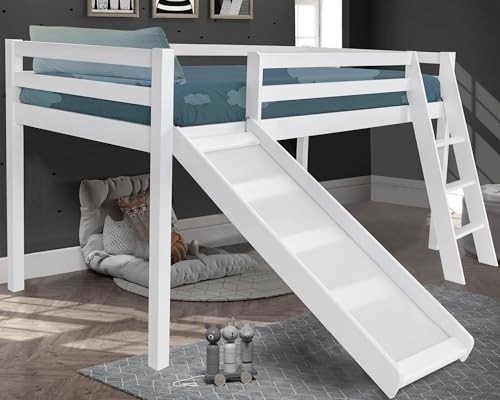The 10 Scariest Things About Bunk Bed For Kids
The Ultimate Guide to Bunk Beds for Kids: Safety, Styles, and Solutions
Bunk beds have long been a popular option amongst parents looking for to optimize space in their children's bedrooms. With advantages that surpass their compact design, bunk beds offer a fun and functional sleeping plan while motivating brother or sister bonding and cultivating creativity. In this detailed guide, we explore various aspects of bunk beds for kids, consisting of security factors to consider, various designs offered, and suggestions for picking the best one for your family.
Why Choose Bunk Beds?
Bunk beds are developed to stack one bed on top of another, making use of vertical space to create more space for play and storage. They are especially helpful for families with numerous children or restricted bedroom space. In addition, they supply an adventurous sleeping environment that kids typically delight in.
Secret Advantages of Bunk Beds:
- Space-saving style: Ideal for small spaces or shared areas.
- Cost-efficient: Often more budget-friendly than purchasing 2 different beds.
- Motivates social interaction: Promotes bonding among siblings or pals.
- Versatile alternatives: Available in numerous designs and setups to suit any room design.
Safety First: Essential Considerations
When picking a bunk bed for kids, security ought to be the leading priority. The following features are crucial for guaranteeing a safe sleeping environment:
Important Safety Features:
- Sturdy Construction: Ensure that the bed frame is made of resilient products such as solid wood or metal.
- Guardrails: Bunk beds should have guardrails on both sides of the upper bunk to prevent falls.
- Ladder Safety: A tough, built-in ladder or stairs with anti-slip rungs is necessary for safe access to the top bunk.
- Weight Limit: Check the manufacturer's weight limitation capacity for both the leading and bottom bunk.
- Mattress Size: Use the right mattress size as specified by the bed producer to guarantee a snug fit within the bed frame.
Safety Tips for Parents:
- Monitor Sleep Habits: Teach children the value of not using or leaping off the bunk beds.
- Age Appropriateness: Generally, the upper bunk appropriates for children aged 6 and older.
- Routine Inspections: Periodically look for any loose bolts, screws, or structural damage.
Designs of Bunk Beds
Bunk beds can be found in a range of styles, permitting moms and dads to select one that matches their child's space decoration while conference specific requirements. Below are some popular designs:
Popular Bunk Bed Styles:
- Traditional Bunk Beds: Simple and classic styles made of wood or metal without any additional functions.
- Loft Beds: Features a raised top bunk with space beneath for a desk, play location, or extra storage.
- L-Shaped Bunk Beds: Arranged in an L-shape, frequently perfect for corner areas and can have additional storage choices.
- Twin over Full Bunk Beds: A twin bed on leading and a bigger full-sized bed on the bottom, accommodating kids or teens of various ages.
- Triple Bunk Beds: Designed to fit three beds in a single footprint, perfect for bigger households or pajama parties.
A Comparison of Bunk Bed Styles
Bunk Bed Style
Description
Best For
Traditional
Traditional style with 2 stacked beds
Requirement bed room setups
Loft Bed
Raised bed with functional space beneath
Homework or play locations
L-Shaped
Bunk beds arranged in an L-shape
Corner spaces
Twin over Full
Twin bed on top, full bed below
Various age brother or sisters
Triple Bunk
Three stacked beds
Big households or sleepovers
Choosing the Right Bunk Bed
When searching for the ideal bunk bed, consider the list below factors to ensure you make an informed decision:
Key Factors to Consider:
- Room Size: Measure the space dimensions to figure out the appropriate size and height of the bunk bed.
- Child's Age: Consider the age of your child(ren) when picking a design and safety functions.
- Functionality: Think about how much storage or play space you require and whether the bunk bed need to serve extra functions.
- Budget plan: Set a spending plan that consists of not just the bunk bed but also the needed mattress and devices like bedding or safety gates.
FAQs About Bunk Beds for Kids
1. What age is suitable for a kid to oversleep the leading bunk?
Typically, children aged 6 and older need to be able to safely sleep in the top bunk, though you ought to always consider your child's maturity level.
2. Are bunk beds safe for young children?
It is not a good idea for young children or really young kids to oversleep the top bunk due to the danger of falling.
3. How do I maintain the bunk bed?
Examine the bed regularly for any indications of wear and tear, tightening up screws, and cleaning up the bed mattress to guarantee prolonged safety and durability.
4. Can I convert a bunk bed into 2 separate beds?
Many bunk beds are designed to be convertible, permitting you to separate the beds when required. Check the producer's specifications before buying.
5. How can lewisfranco.top maximize space in a bunk bed space?
Use under-bed drawers, shelves, or lofted styles to produce additional storage services in a space with a bunk bed.
Bunk beds offer a delightful blend of fun, functionality, and space-saving energy, making them a perfect option for young households. By thinking about safety features, numerous designs, and practical factors such as space size and age appropriateness, moms and dads can choose the best bunk bed for their child's needs. With the best choice, bunk beds can transform a bedroom into a wonderful space that encourages play, creativity, and bonding amongst brother or sisters. Constantly remember to prioritize security and upkeep to make the most of this special sleeping arrangement.
